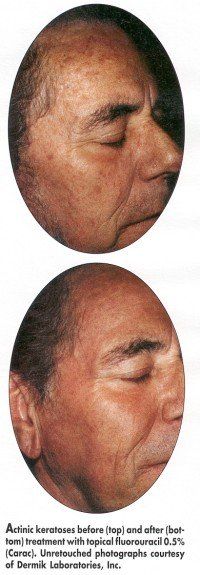New 0.5% Topical Fluorouracil Preparation for Actinic Keratosis
NEW YORK-A topical sustained-release fluorouracil product for actinic keratosis that is applied once a day is now available from Dermik Laboratories (Beryn, Penn). The concentration of active ingredient in the new product, Carac, is 0.5%, or one tenth that in most fluorouracil creams. In clinical trials, use of the preparation cleared more than 70% of actinic keratoses within 1 week.
NEW YORKA topical sustained-release fluorouracil product for actinic keratosis that is applied once a day is now available from Dermik Laboratories (Beryn, Penn). The concentration of active ingredient in the new product, Carac, is 0.5%, or one tenth that in most fluorouracil creams. In clinical trials, use of the preparation cleared more than 70% of actinic keratoses within 1 week.
"Early data suggest that it works just as well as a 5% product," Sharon Levy, MD, Dermik’s director of clinical research and medical affairs, said at a press conference introducing Carac. "Less is more in this case." The 5% products, she noted, are usually applied twice a day. The new product was approved by the FDA at the end of 2000 and became commercially available in March 2001.

The two pivotal phase III double-blind placebo-controlled clinical trials of Carac enrolled 384 patients, who had an average of 15 actinic keratoses each, Dr. Levy said. All had more than 5 lesions. Equal numbers of patients were assigned to 1-week, 2-week, and 4-week regimens. Four weeks after treatment stopped, physicians re-counted the number of actinic keratoses on each patient.
In patients treated for a week, 73.9% of the lesions disappeared, Dr. Levy reported. With 2 weeks of treatment, the clearance rate rose to 85% and with 4 weeks, to 90.4%. "Actually we were really surprised at this," she said, "because going into this program, we had no idea that we would get such a big effect just by a week of treatment."
A 27.8% reduction occurred in the placebo group, which Dr. Levy described as a typical response that may be due to activity of the body’s immune surveillance system or to the flaking of superficial lesions.
Skin irritation with use of Carac was expected Dr. Levy said, and takes the form of redness, dryness, and swelling, and sometimes crusting of the actinic keratoses. The irritation usually begins on the fourth day of treatment, she said, and increases as the applications continue but plateaus at 2 to 3 weeks in courses running 4 weeks.
"The most remarkable part is how quickly the irritation subsides once you stop the application," she said. "The irritation starts dropping off right away." Within 2 weeks, the irritation is about the same as that seen when the patient began treatment, she noted, and 4 weeks after stopping applications, the skin is smoother than before therapy.
Joseph L. Jorizzo, MD, professor and chair, Department of Dermatology, Wake Forest University School of Medicine, contrasted the skin irritation seen with Carac with the generally longer-lasting and more severe irritation seen with twice-daily use of 5% fluorouracil creams, which typically call for a 4-week course.
With the standard 5% creams, Dr. Jorizzo said, "the patient looks like a lobster for 4 to 8 weeks afterwards. That’s not an acceptable therapy from the patient’s standpoint."
The lower concentration of fluorouracil and once-a-day dosing of Carac, Dr. Levy noted, are made possible by the Microsponge delivery system. Developed by Advanced Polymer Systems, Micro-sponge facilitates a sustained rate of release of active ingredients.
Three-Step Process
Dr. Jorizzo, who participated in the clinical trials of Carac, said that the monitoring and treatment of sun-damaged skin should be a three-step process. The first step, he said, is to check for skin cancers. Any melanomas or squamous or basal cell carcinomas, he stressed, must be surgically resected. The second step, is to remove any hypertrophic actinic keratosis using cryosurgery.
The third step, chemical treatment with a fluorouracil cream, he said, is useful for removal of flat superficial actinic keratoses and also as an adjunct to cryosurgery for targeting areas of invisible "pre-actinic keratoses."
Between the visible actinic keratoses, which may be removed with cryosurgery or a cream, Dr. Levy said, undoubtedly lie other areas with damaged cells. "They’re just waiting to pop up, and the use of a fluorouracil creama blanket kind of treatmenthas the advantage of potentially targeting those other sites that you don’t see today, those actinic keratoses you could see in the future."
It is important for dermatologists "to follow the sequence correctly," he said. "You do not want to miss cancers and jump ahead to freezing. You do not want to miss freezing the thickest lesions that might not respond to a topical agent. And for just about everyone, you want to consider using a chemical chemotherapy treatment to mop up those in-between and early lesions."
While actinic keratoses have long been considered precancerous lesions, Dr. Jorizzo pointed out that recent molecular research has determined that the damaged cells seen in actinic keratoses are identical to those taken from invasive squamous cell carcinomas. A diagnosis of actinic keratosis, he advised, therefore should prompt the same marshaling of the medical armamentarium as a positive Pap smear does for cervical cancer.
"Actinic keratosis is not yet invasive," he said. "It has not yet spread. But it can evolve into an invasive squamous cell carcinoma that can spread and be fatal. By treating the actinic keratosis, we stop that progression."
How Supportive Care Methods Can Improve Oncology Outcomes
Experts discussed supportive care and why it should be integrated into standard oncology care.